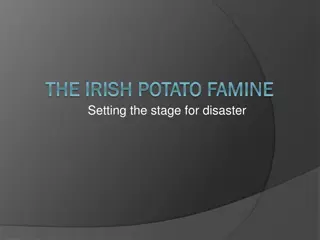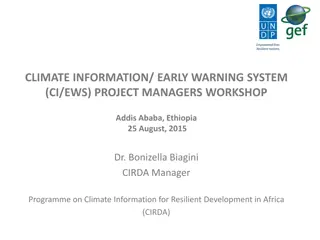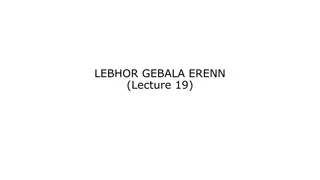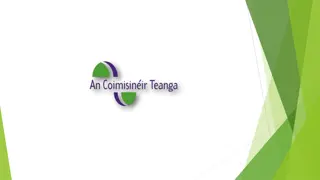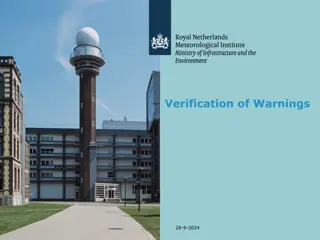Understanding the Irish National Early Warning System (NEWS)
The Irish National Early Warning System (NEWS) serves as a vital tool in acute settings for identifying and responding to deteriorating patients. Introduced in 2013, NEWS assists in classifying patient conditions, provides communication tools for escalating care, and emphasizes the role of clinical judgment. This presentation aims to educate healthcare staff on utilizing NEWS effectively, emphasizing patient safety and timely intervention. By familiarizing with NEWS, staff can better recognize acutely unwell patients, utilize observation charts, and understand the importance of effective communication through ISBAR. NEWS encompasses anticipation, assessment, escalation protocols, and evaluation to ensure a comprehensive approach to patient care.
Download Presentation

Please find below an Image/Link to download the presentation.
The content on the website is provided AS IS for your information and personal use only. It may not be sold, licensed, or shared on other websites without obtaining consent from the author. Download presentation by click this link. If you encounter any issues during the download, it is possible that the publisher has removed the file from their server.
E N D
Presentation Transcript
Irish National Early Warning System (NEWS)NCEC NCG 2013 Using NEWS 1 DPIP MARCH 2020
Welcome to the NEWS 2 The NCEC National Clinical Guideline (NCG) No.1 NEWS was introduced into acute hospitals in 2013 NCG No.1 NEWS (2013) is currently in use in Irish hospitals The revised guideline which will become INEWS (Irish National Early Warning System) will be published in June 2020 NEWS is an adjunct to clinical judgement and is used to support the clinician in recognising and responding to the deteriorating patient; NEWS does not supersede clinical judgement DPIP MARCH 2020
Aim and Audience 3 The purpose of this presentation is to provide information about how to use NEWS for staff in acute settings who may not previously have used NEWS or may not be familiar with NEWS. DPIP MARCH 2020
Learning Outcomes 4 When you finish this presentation you should be able to: Use NEWS to help you identify a patient who may be acutely unwell and deteriorating Navigate the NEWS observations chart and use it to record, track and trend clinical observations and escalate patient care appropriately if required Recognise the role of ISBAR in effective communication Note: You will need to familiarise yourself with your hospital s NEWS escalation and response protocol DPIP MARCH 2020
What is NEWS? What is it for? 5 NEWS is an early warning system used in the care of the non- pregnant adult ( 16 years) patient in the acute setting. NEWS is a system that facilitates the timely assessment of and response to the deterioration of acutely ill patients by: Assisting in classifying the severity of a patient s condition Providing prompts and structured communication tools to escalate care DPIP MARCH 2020
What is NEWS? What is it for? 6 NEWS as a system encompasses the anticipation, recognition, assessment, escalation, response and evaluation of the deteriorating patient. NEWS consists of: Clinical judgement (anticipation, recognition and assessment) A track and trigger tool (the NEWS observation chart)(recognition and assessment) An escalation and response protocol (escalation for nursing or medical review and structured appropriate clinical response mechanism) Closed loop governance (evaluation of patient and process) DPIP MARCH 2020
NEWS is of benefit in clinical practice for the following reasons: NEWS provides a single standardised early warning system for the early detection of acute deterioration in the non-pregnant adult ( 16 years) patient It provides a common language to aid communication between health care providers It provides an adjunct to clinical judgement in the identification, assessment, escalation and response to clinical deterioration It provides a standardised score to determine illness severity to support clinical decision making and an appropriate clinical response It supports an anticipatory care approach to the management of the acutely unwell patient It can help to improve the timely recognition and response to deteriorating patients 7 DPIP MARCH 2020
Introduction to the NEWS observations chart (track and trigger tool) 8 The NEWS chart provides a system for: Recording NEWS physiological observations Alerting staff when these physiological observations fall outside accepted ranges Prompting escalation of care and clinical review. DPIP MARCH 2020
Key elements of NEWS chart 9 The NEWS physiological parameter scoring key The NEWS observation record An Escalation and Response Protocol A prompt to assist in the recognition of suspected sepsis DPIP MARCH 2020
NEWS Scoring Key 10 The NEWS physiological parameters scoring key describes the evidence-based ranges which are considered normal and abnormal for the NEWS physiological parameters. DPIP MARCH 2020
The NEWS observation record 11 The middle pages of the NEWS chart are for recording patient observations DPIP MARCH 2020
NEWS Escalation and Response Protocol 12 The NEWS Escalation and Response Protocol outlines what should be done at what scores and who should be called and when (please familiarise yourself with your hospital s NEWS Escalation and Response Protocol) DPIP MARCH 2020
Sepsis prompt 13 Consider sepsis if a patient s NEWS score is 4 (or 5 on supplementary oxygen) and infection is suspected. This prompt is usually seen in 2 places on the chart: 1. On the NEWS Escalation and Response Protocol under the response column for NEWS scores of 4 6 2. On the back of the NEWS chart as part of the sepsis screening pathway DPIP MARCH 2020
ISBAR 14 ISBAR should be used to frame all communication about a deteriorating patient I (Identify) Identify yourself S (Situation) Describe the situation B (Background) Provide background information A (Assessment) provide your assessment of the clinical condition and situation R (Recommend) Tell the nurse in charge or doctor what your recommendation is and what you need them to do DPIP MARCH 2020
The NEWS physiological observations are: 15 Respiratory rate Oxygen saturation (SpO2) Room air or Supplemental O2 Heart rate Systolic blood pressure (SBP) AVPU (New confusion ( C ) is not currently captured on the NEWS chart but it is important to keep in mind that new confusion is a key early indicator of deterioration; AVPU will become ACVPU in INEWS 2020 where C = new confusion/altered mental status/delirium) Temperature A full set of NEWS observations is recorded each time. DPIP MARCH 2020
The following slides show you how to complete a NEWS chart and obtain a patient s NEWS score 16 DPIP MARCH 2020
Completing the NEWS chart 17 Insert the patient s addressograph Document date, time, ward and the patient s Consultant name Document required frequency of observations DPIP MARCH 2020
18 NEWS allocates a value of 0, 1, 2 or 3 to each of the seven NEWS observations. A value of 0 is given for observations within normal ranges (as defined by the NEWS scoring key) Values of 1, 2 or 3 are given for observations which vary from the normal ranges. Higher values indicate more severe variation. The NEWS chart is colour coded NEWS value of 0 = white NEWS value of 1 = yellow NEWS value of 2 = blue 0 1 2 3 NEWS value of 3 = pink The NEWS observations also include supplemental oxygen - a value of 0 is given for room air and a value of 3 for any O2 DPIP MARCH 2020
Respiratory Rate 19 Changes in a patient s respiratory rate is one of the earliest indicators of deterioration Visually observe or auscultate the chest and count the patient s respiratory rate (RR) for 60 seconds Record the RR per minute on the chart as a number e.g. 19, 20, 21 Enter the NEWS value (0,1,2 or 3) for the RR into the grey row below the RR section DPIP MARCH 2020
Peripheral Oxygen saturation (SpO2) 20 The peripheral O2 saturation (SpO2) is recorded in this section as a percentage e.g 95% Enter the appropriate NEWS value (0,1,2 or 3) for SpO2 into the grey row below the SpO2 section Consider: The patient s SpO2 % relative to supplemental O2 therapy A new or increased O2 requirement is an early sign of deterioration NEWS identifies normal SpO2 as 96% Patients with confirmed chronic respiratory conditions may have lower baseline SpO2 levels. DPIP MARCH 2020
SpO2 measurement using pulse oximetry may be affected by: 21 Nail polish or synthetic nails Poor peripheral perfusion Cardiac arrhythmias such as atrial fibrillation Recording BP on the same arm as the pulse oximeter Shivering or restlessness Inappropriately sized probes or dirty probe sensors Anaemia Hypothermia DPIP MARCH 2020
Room Air/Supplemental Oxygen 22 A new oxygen requirement or an increasing oxygen requirement is a significant sign of deterioration Enter the appropriate NEWS value ( 0 for Room air / 3 for any O2 ) into the grey row below this section If a patient is on any inspired oxygen a NEWS value of 3 is given Consider If O2 is prescribed, the target SpO2 for the patient should be written on the drug chart Aim for lowest amount of oxygen to achieve patient s target SpO2 All deteriorating patients should be positioned appropriately and receive oxygen as an immediate measure before further assessment DPIP MARCH 2020
Blood Pressure 23 Record the BP as two closed arrows connected by a dotted line The NEWS value applies to the Systolic BP (SBP) look to see what colour the SBP arrow lies within (white, yellow, blue or pink) and score accordingly Enter the appropriate NEWS value (0, 1, 2 or 3) for the Systolic BP into the grey row below this section DPIP MARCH 2020
Heart rate 24 Assess the patient s heart rate by palpating and counting for 60 seconds. Digital monitoring can be used to measure the heart rate, but good practice would suggest that manual assessment is used to determine amplitude, volume and regularity Record the heart rate as a dot; indicate HR trend as a solid line connecting dots Enter the appropriate NEWS value (0,1,2 or 3) into the grey row below the HR section DPIP MARCH 2020
Neurological response 25 AVPU is the scale used to determine neurological deterioration. AVPU is: Alert: Patient is alert and oriented to person, place, time and event. Voice : The patient responds to verbal stimuli Pain: The patient responds to painful stimuli with a purposeful or non-purposeful movement. Unresponsive: The patient does not respond to stimuli. DPIP MARCH 2020
Neurological response 26 A value of 0 is given for Alert and a value of 3 for anything else ie VPU. Enter the appropriate NEWS value (0,1,2 or 3) into the grey row below the AVPU section If value is 3 or you are concerned about the patient s mental status consider completing a Glasgow Coma Scale Note: AVPU will change to ACVPU (C = new confusion) in the revised NEWS 2020 as new confusion is a key indicator of acute deterioration. Please keep this fact in mind when assessing patient. DPIP MARCH 2020
Neurological response (contd.) 27 Minor change from orientated to new confusion is significant. Discuss patient s baseline with family Patient who is alert but confused needs immediate referral to a doctor. Any change in ACVPU must be considered significant and must be acted on immediately. Rule out hypoglycaemia Check blood glucose in any confused, unconscious or fitting patient whether they are diabetic or not. Assess using the Glasgow Coma Scale if needed DPIP MARCH 2020
Temperature 28 Temperatures should be recorded at the appropriate site (oral, axilla, tympanic) according to your local guidelines. Record the time of measurement and use of any antipyretic drugs (to lower temperature) according to local policy Enter the appropriate NEWS value (0,1,2 or 3) into the grey row below the Temperature section DPIP MARCH 2020
NEWS total and initials 29 To obtain a patient's NEWS Score add the value given to each of the seven NEWS observations and total them Enter the total NEWS score into the Total NEWS score row Refer to the NEWS Escalation and Response Protocol on the front of the chart to determine next steps If you are concerned about a patient escalate care regardless of NEWS score (i.e. low or no scores) Insert your initials in the row provided at the bottom of the chart Consider recording observation frequency, pain score, blood glucose, bowel movement and time within which patient should be reassessed Nursing students on clinical placement have entries countersigned by a registered nurse (as per local policy). DPIP MARCH 2020
A completed NEWS chart 30 DPIP MARCH 2020
Escalation and response 31 Once you know the patient s NEWS score, you may need to escalate care. When thinking about who to escalate to, consult your local escalation and response protocol. Communicate any triggers and/or concerns to the nurse in charge Continue to monitor a patient pending and following escalation and review. DPIP MARCH 2020
Nurse, Doctor, Patient , Family or Carer concern 32 While the NEWS observations chart does not currently capture nurse/doctor/patient/family concern it is an important indicator of patient deterioration. If you as a nurse or doctor have concern about a patient care should be escalated regardless of NEWS score. Of equal importance if the patient or their family have concerns about changes in the patient s condition these concerns should be taken seriously by healthcare professionals and acted upon. (Note: The revised INEWS 2020 observation chart will capture nurse/doctor/patient/family concern). DPIP MARCH 2020
Other considerations 33 Depending on the patient s clinical condition and your clinical judgement consideration may need to be given to clinical observations outside of the NEWS physiological parameters DPIP MARCH 2020
Urine output 34 Decreased urine output is a sign of deterioration (<0.5mls/kg/hr) Small window of opportunity to prevent acute renal failure Escalate urgently to determine cause and commence treatment Accurate fluid balance monitoring Examining incontinence products for frequency of changing, colour and odour to assess fluid output DPIP MARCH 2020
Sepsis 35 Consider sepsis if there is a suspicion of infection in a patient with a NEWS score 4 (or 5 if on oxygen) and/or If the patient is in one of the 3 high-risk categories below: Always use clinical judgement and escalate for medical review if there is deterioration in clinical condition due to an infection regardless of the NEWS score. In some patient groups (including the elderly and those immunosuppressed due to a medical condition or medication), sepsis can initially be asymptomatic with an NEWS score of <4. DPIP MARCH 2020
Other clinical observations 36 Additional observations depending on patient s clinical condition may support the timely recognition of deterioration: Fluid balance Glasgow Coma Scale Pain Respiratory effort Pallor Capillary refill Sweating Nausea and vomiting DPIP MARCH 2020
Summary 37 NEWS is an early warning system used in the care of the non-pregnant adult ( 16 years) patient in the acute setting. NEWS is used to aid clinical judgement and clinical decision-making; if you are worried about a patient escalate care regardless of NEWS score NEWS is a system that facilitates the timely assessment of and response to the deterioration of acutely ill patients by: Assisting in classifying the severity of a patient s condition Providing prompts and structured communication tools to escalate care appropriately DPIP MARCH 2020















